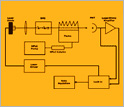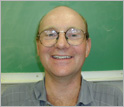|

Discovery
It’s Elemental: Detecting Toxicity in a Controversial Fuel Additive

U.S.-German Team Develops New Analytical Technique
January 27, 2005
Controversy has surrounded the potential toxicity of the fuel additive Methylcyclopentadienyl Manganese Tricarbonyl (MMT) since it was first introduced as an octane-boosting, anti-knocking agent in Canada in 1977. Initially denied approval for widespread use in the United States, MMT was only approved for limited use in leaded gasoline from 1977 to 1995. In 1995, the manufacturer of MMT challenged the denial in court and won, thereby opening the door for MMT to be marketed for use in unleaded gasoline as well.
Although it is known that inhalation of high levels of manganese can lead to serious neurological impairment in humans, the health risks associated with widespread use of MMT in gasoline remain unknown because of insufficient knowledge of its combustion products and toxicity. And until recently, relatively easy, cost-effective methods for isolating and identifying specific compounds of manganese were not available.
In a collaborative effort funded by NSF's Office of International Science and Engineering, Principal Investigator Dr. David Butcher of Western Carolina University teamed with Dr. Kay Niemax and Dr. Michail Bolshov from the University of Dortmund, Germany, to develop an efficient method for identifying and quantifying the combustion products of MMT.
The team employed the process of "speciation," which is a method of determining how much of each chemical form of a metal is present in a sample. Considerable interest has developed in speciation over the past twenty years because the toxicity and mobility of metals in the environment and its organisms is dependent upon their chemical form. In the case of manganese, different levels of toxicity exist in each of the various manganese compounds.
Most techniques for metal speciation involve the combination of chromatography (the process of separating small quantities of a mixed substance through selective absorption) and an atomic laser spectrometry detector (which uses the spectroscopic processes of atom excitation and emission to analyze and measure samples). The instrumentation is complicated and relatively expensive to use.
Dr. Butcher first studied MMT while in graduate school at the University of Connecticut and currently specializes in environmental research. After the court's reversal on MMT usage, he became interested in resuming work on the substance. Having worked extensively with laser spectroscopy, he was convinced that the equipment could be easily adapted for an analysis of MMT and its derivatives. But he hadn't previously worked with diode laser spectroscopy. As it happened, Dr. Butcher was already acquainted with two leaders in the field of diode laser spectroscopy, both at the Institute of Spectrochemistry and Applied Spectroscopy at the University of Dortmund, Germany.
"As far as atomic spectrometry groups go, there aren't that many of us," Dr. Butcher explains. "And Germany leads the field in using diode laser spectrometry for elemental analysis. I'd met Professor Niemax and Professor Bolshov several times in the past, and together we formulated the idea."
NSF provided funding for Dr. Butcher to join the German researchers for a number of weeks in the laboratory in Germany, where the diode laser atomic absorption technique was originally developed, and where the most advanced equipment resided.
A Winning Combination
In order to analyze the compounds in the combustion products of MMT, including its nonmethylated derivative, cyclopentadienyl manganese carbonyl (CMT), the team devised their new technique by coupling high performance liquid chromatography (HPLC) with diode laser atomic absorption spectrometry (DLAAS).
"In simple terms, a flame burns everything until you wind up with atoms," Dr. Butcher explains. "Then you shine a laser beam through the flame to a wave length that only the manganese atoms can absorb. You do your quantitative analysis by measuring the amount of light absorbed by the manganese atoms."
Superior Performance
The new instrumentation streamlined the process of identifying and quantifying manganese compounds from among the hundreds and hundreds of compounds contained in gasoline. It also improved considerably on analysis time compared to previous methods, bringing it down to 3 minutes per sample, and improved significantly on the analytical performance of previous methods with increased sensitivity. It also proved to be far less complicated to use, making it a more practical technique for real-world applications.
The usefulness of the technique for real sample analysis was further verified by the accurate determination of MMT in spiked gasoline, urine, and water samples.
Dr. Butcher hopes to pursue a number of future research scenarios involving controlled introduction of MMT into simulated groundwater and replicated soil landscapes.
"One of the things that's interesting about MMT is that it is stabilized in the soil, so it's possible, if it is spilled on the ground, it will stick around for a long while," he said. "Given MMT's photosensitivity, you would think it would decompose, but it doesn't."
-- S2N Media
Investigators
David Butcher
Related Institutions/Organizations
University of Dortmund
Western Carolina University
Locations
North Carolina
Germany
Related Awards
#9902679 U.S.-Germany Cooperative Research: Speciation of Methylcyclopentadienyl Manganese Tricarbonyl by High Performance-Diode Laser Atomic Absorption Spectroscopy
Years Research Conducted
1999
Total Grants
$3,915
Related Websites
Dr. David J. Butcher's web site: http://wcuvax1.wcu.edu/~butcher/
|








